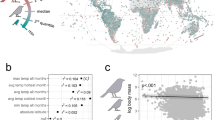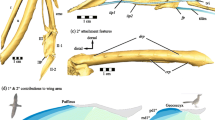Summary
Interspecific scaling relationships (e.g. of limb size with body mass) in vertebrates are usually assumed to be functional (e.g. biomechanical) attributes. In this paper on the Anatidae, we study the scaling of wing length and tarsus length with body mass, relationships that can be expected to have biomechanical significance. At an interspecific level, both wing length and tarsus are positively allometric, a finding consistent with results from previous comparative avian studies. These trends remained significant in regressions controlling for the effects of phylogeny, but interspecific slopes were less steep within tribes than in the whole family (a taxon-level effect). We are not aware of any biomechanical resasons that explain these patterns satisfactorily. Intraspecific (static) allometries in Green-winged Teal (Anas crecca) and Marbled Teal (Marmaronetta angustirostris) are different: wing length is negatively allometric and tarsus is isometric. These anomalies suggest that interspecific and intraspecific scaling relationships do not share common causes. Our results bring into question the significance of interspecific allometries in vertebrate morphology, which may to some extent be non-functional by-products of morphological optimisation processes within species and ecological differences between them.
Zusammenfassung
Bei Vertebraten werden auf dem interspezifischem Niveau Größenbeziehungen (z. B. Gliedmaßenlänge mit Körpergewicht) üblicherweise funktional (z. B. bio-mechanisch) erklärt. In der vorliegende Studie untersuchen wir die Größenbeziehungen von Flügel- und Tarsuslänge mit der Körpermasse bei Anatiden. Es ist zu erwarten, daß diese Beziehungen biomechanische Bedeutung haben. Auf dem interspefischen Niveau (morphometrische Daten von 42 westpaläarktischen Arten wurden untersucht) sind sowohl Flügellänge als auch Tarsuslänge positiv allometrisch, d. h. länger mit zunehmender Masse. Dieses Ergebnis stimmt mit früheren, vergleichenden Studien an Vögeln überein. Diese Trends waren auch in Regressionsanalysen signifikant, in denen auf die Effekte der Phylogenie kontrolliert wurde. Allerdings, waren die interspezifischen Steigungen innerhalb der Triben geringer als in ganzen Familien (Effekt des taxonomischen Niveaus). Für diese Muster haben wir keine befriedigende biomechanische Erklärung. Intraspezifische (statische) Allometrien in einjährigen Krickenten (Anas crecca) und Marmelenten (Marmaronetta angustirostris) unterscheiden sich: die Flügellänge ist hier negativ allometrisch (d. h. relativ kürzer bei steigender Masse), die Tarsuslänge ist isometrisch. Diese Anomalien weisen darauf hin, dass inter-und intraspezifischen Größenbeziehungen keine gemeinsame Erklärung zugrunde liegen. Unsere Ergebnisse stellen die Bedeutung von interspezifischen Allometrien in der Morphologie von Vertebraten in Frage. Sie könnten zum Teil nichtfunktionelle Nebenprodukte von morphologischer Spezialisierung innerhalb von Arten, aber auch von ökologischen Unterschieden zwischen Arten sein.
Similar content being viewed by others
References
Batt, B. D. J, Afton, A. D., Anderson, M. G., Ankney, C. D., Johnson, D. H., Kadlec, J. A. & Krapu, G. L., Eds., (1992): Ecology and Management of Breeding Waterfowl. Minneapolis.
Balmford, A., Jones, I. L. & Thomas, A. L. R. (1994): How to compensate for costly sexually selected tails: the origin of sexually dimorphic wings in long-tailed birds. Evolution 48: 1062–1070.
Bertram, J. E. A. & Biewener, A. A. (1992): Allometry and curvature in the long bones of quadrupedal mammals. J. Zool, Lond. 226: 455–467.
Björklund, M. (1994): Allometric relations in three species of finches (Aves: Fringillidae). J. Zool, Lond. 233: 657–668.
Boag, P. T. (1984): Growth and allometry of external morphology in Darwin's finches (Geospiza) on Isla Daphne Major, Galapagos. J. Zool, Lond. 204: 413–441.
Brown, M. E. (1996): Assessing body condition in birds. In: V. Nolan & E. D. Ketterson (Eds.): Current Ornithology. Vol 13: 67–135. New York.
Calder, W. A. (1984): Size, function, and life history. Cambridge, Massachusetts.
Castro, G. & Myers, J. P. (1990): Validity of predictive equations for total body fat in sanderlings from different nonbreeding areas. Condor 92: 205–209.
Cramp, S. & Simmons, K. E. L., Eds., (1977): The birds of the western Palearctic, vol. 1. Oxford.
Crawley, M. J. (1993): GLIM for ecologists. Oxford.
Demes, B. & Jungers, W. L. (1993): Long bone cross-sectional dimensions, locomotor adaptations and body size in prosimian primates. J. Hum. Evol. 25: 57–74.
Feldman, H. A. (1995): On the allometric mass exponent, when it exists. J. Theor. Biol. 172: 187–197.
Felsenstein, J. (1985): Phylogenies and the comparative method. Am. Nat. 125: 1–15.
Fox, A. D., King, R. & Watkin, J. (1992): Seasonal variation in weight, body measurements and condition of free-living Teal. Bird Study 39: 53–62.
Garland, T., Jr., Harvey, P. H., & Ives, A. R., (1992): Procedures for the analysis of comparative data using phylogenetically independent contrasts. Syst. Biol. 41: 18–32.
Gosler, A. G., Greenwood, J. J. D., Baker, J. K. & Davidson, N. C. (1998): The field determination of body size and condition in passerines: a report to the British Ringing Committee. Bird Study 45: 92–103.
Grafen, A. (1989): The phylogenetic regression. Phil. Trans. Roy. Soc. B 326: 119–156.
Green, A. J. (2000): Sexual dimorphism in morphometry and allometry in the Marbled TealMarmaronetta angustirostris. J. Avian Biol. 31: 345–350.
Green, A. J. & El Hamzaoui, M. (2000): Diurnal behaviour and habitat use of non-breeding Marbled TealMarmaronetta angustirostris. Can. J. Zool. 78:
Harvey, P. H. & Krebs, J. R. (1990): Comparing brains. Science 249: 140–146.
Harvey, P. H. & Pagel, M. D. (1991): The comparative method in evolutionary biology. Oxford.
Jolicoeur, P. (1990): Bivariate allometry: interval estimation of the slopes of the ordinary and standardized normal major axes and structural relationship. J. Theor. Biol., 144, 275–285.
Kehoe, F. P. & Thomas, V. G. (1987): A comparison of interspecific differences in the morphology of external and internal feeding apparatus among North American Anatidae. Can. J. Zool. 65: 1818–1822.
Klingenberg, C. P. & Zimmermann, M. (1992): Static, ontogenetic, and evolutionary allometry: a multivariate comparison in nine species of water striders. Am. Nat. 140: 601–620.
Kooloos, J. G. M., Kraaijeveld, A. R., Langenbach, G. E. J. & Zweers, G. A. (1989): Comparative mechanics of filter feeding inAnas platyrhynchos, Anas clypeata andAythya fuligula (Aves, Anseriformes). Zoomorphology 108: 269–290.
Kozlowski, J. & Weiner, J. (1997): Interspecific allometries are by-products of body size optimization. Am. Nat. 149: 352–380.
LaBarbera, M. (1989): Analyzing body size as a factor in ecology and evolution. Ann. Rev. Ecol. Syst. 20: 97–117.
Legendre, P. & Legendre, L. (1998): Numerical ecology. Amsterdam.
Livezey, B. C. (1986): A phylogenetic analysis of recent Anseriform genera using morphological characters. Auk 103: 737–754.
Livezey, B. C. (1989a): Phylogenetic relationships and incipient flightlessness of the extinct Auckland Islands Merganser. Wilson Bull. 101: 410–435.
Livezey, B. C. (1989b): Flightlessness in grebes (Aves, podicipedidae): its independent evolution in three genera. Evolution 43: 29–54.
Livezey, B. C. (1990): Evolutionary morphology of flightlessness in the Auckland Islands teal. Condor 92: 639–673.
Livezey, B. C. (1991): A phylogenetic analysis and classification of recent dabbling ducks (tribe Anatini) based on comparative morphology. Auk 108: 471–507.
Livezey, B. C. (1993): Comparative morphometrics ofAnas ducks, with particular reference to the Hawaiian DuckAnas wyvilliana, Laysan DuckA. laysanensis, and Eaton's PintailA. eatoni. Wildfowl 44: 75–100.
Livezey, B. C. (1995a): Phylogeny and comparative ecology of stiff-tailed ducks (Anatidae: Oxyurini). Wilson Bull. 107: 214–234.
Livezey, B. C. (1995b): Phylogeny and evolutionary ecology of modern seaducks (Anatidae: Mergini). Condor 97: 233–255.
Livezey, B. C. (1996a): A phylogenetic analysis of modern pochards (Anatidae: Aythyini). Auk 113: 74–93.
Livezey, B. C. (1996b): A phylogenetic analysis of geese and swans (Anseriformes: Anserinae), including selected fossil species. Syst. Biol. 45: 415–450.
Livezey, B. C. (1997): A phylogenetic analysis of modern sheldgeese and shelducks (Anatidae, Tadornini). Ibis 139: 51–66.
Livezey, B. C. & Humphrey, P. S. (1986): Flightlessness in steamer-ducks (Anatidae:Tachyeres): its morphological bases and probable evolution. Evolution 40: 540–558.
Martin, R. D. & Barbour, A. D. (1989): Aspects of line-fitting in bivariate allometric analyses. Folia Primatologia 53: 65–81.
Mazer, S. J. & Wheelwright, N. T. (1993): Fruit size and shape: allometry at different taxonomic levels in bird-dispersed plants. Evol. Ecol. 7: 556–575.
McArdle, B. H. (1988): The structural relationship: regression in biology. Can. J. Zool. 66: 2329–2339.
Navarro, J. D., Green, A. J. & Aranda, J. C. (1995): Status of Marbled Teal in southern Alicante, Spain. IWRB Threatened Waterfowl Research Group Newsletter 8: 7–10.
Nudds, T. D. & Bowlby, J. N. (1984): Predator-prey size relationships in North American dabbling ducks. Can. J. Zool. 62: 2002–2008.
Nudds, T. D. & Kaminski, R. M. (1984): Sexual size dimorphism in relation to resource partitioning in North American dabbling ducks. Can. J. Zool. 62: 2009–2012.
Pagel, M. D. & Harvey, P. H. (1988): The taxon-level problem in the evolution of mammalian brain size: facts and artifacts. Am. Nat. 132: 344–359.
Pagel, M. D. & Harvey, P. H. (1989): Taxonomic differences in the scaling of brain on body weight among mammals. Science 244: 1589–1593.
Parker Cane, W. (1993): The ontogeny of postcranial integration in the Common Tern,Sterna hirundo. Evolution 47: 1138–1151.
Pehrsson, O. (1987): Effects of body condition on molting in Mallards. Condor 89: 329–339.
Pennycuick, C. J. (1989): Bird flight performance. A practical calculation manual. Oxford.
Peters, R. H. (1983): The ecological implications of body size. Cambridge.
Prange, H. D., Anderson, J. F. & Rahn, H. (1979): Scaling of skeletal mass to body mass in birds and mammals. Am. Nat. 113: 103–122.
Price, M. V. (1993): A functional-morphometric analysis of forelimbs in bipedal and quadrupedal heteromyid rodents. Biol. J. Linn. Soc. 50: 339–360.
Purvis, A. & Rambaut, A. (1995): Comparative analysis by independent contrasts (CAIC): an Apple Macintosh application for analysing comparative data. Computer Appl. Biosciences 11: 247–251.
Raikow, R. J. (1973): Locomotor mechanisms in North American ducks. Wilson Bull. 85: 295–307.
Rayner, J. M. V. (1985): Linear relations in biome-chanics: the statistics of scaling functions. J. Zool, Lond. 206: 415–439.
Rayner, J. M. V. (1988): Form and function in avian flight. In:. R. F. Johnston (Ed.): Current Ornithology. Vol. 5: 51–66. New York.
Ricker, W. E. (1984): Computation and uses of central trend lines. Can. J. Zool. 62: 1897–1905.
Schmidt-Nielsen, K. (1984): Scaling: why is animal size so important? Cambridge.
Scott, D. A. & Rose, P. M. (1996): Atlas of Anatidae populations in Africa and Western Eurasia. Wetlands International Publ. 41. Wageningen, the Netherlands: Wetlands International.
Senar, J. C., Lleonart, J. & Metcalfe, N. B. (1994): Wing-shape variation between resident and transient wintering SiskinsCarduelis spinus. J. Avian Biol. 25: 50–54.
Silva, M. (1998): Allometric scaling of body length: elastic or geometric similarity in mammalian design. J. Mamm. 79: 20–32.
Simmons, L. W. & Tomkins, J. L. (1996): Sexual selection and the allometry of earwig forceps. Evol. Ecol. 10: 97–104.
Simmons, R. E. & Scheepers, L. (1996): Winning by a neck: sexual selection in the evolution of giraffe. Am. Nat. 148: 771–786.
Sokal, R. R., & Rohlf, F. J. (1995): Biometry. New York.
Worcester, S. E. (1996): The scaling of the size and stiffness of primary flight feathers. J. Zool, Lond. 239: 609–624.
Author information
Authors and Affiliations
Corresponding author
Rights and permissions
About this article
Cite this article
Green, A.J., Figuerola, J. & King, R. Comparing interspecific and intraspecific allometry in the Anatidae. J Ornithol 142, 321–334 (2001). https://doi.org/10.1007/BF01651371
Accepted:
Published:
Issue Date:
DOI: https://doi.org/10.1007/BF01651371




